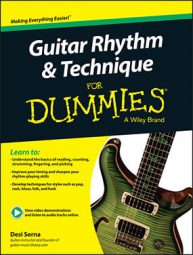When playing the guitar, not all notes have values. In some situations you use a pitch to quickly lead into another, and it’s sounded only for a very brief moment. This is called a grace note. Grace notes are written in a score as smaller notes set slightly apart from the primary ones. They aren’t counted and don’t contribute to a measure’s number of beats.
Notes quickly played around central notes are called ornaments or embellishments. They serve to decorate or “ornament” a note. A grace note is a type of ornament.
On guitar, grace notes are often the first pitch of an immediate hammer-on. The idea in this example is to play an E5 but lead into it with another pitch. As you put your first and third fingers into place to play the common power chord shape, barre with your first finger to cover both the sixth and fifth strings.
Then, instead of sounding the chord tones straight up, strum the strings without your third (fret hand) finger, which means that you hear the A note under your first finger at the 12th fret of the fifth string, then immediately hammer into the 14th fret of the fifth string.
Although the tab seems to indicate that the 12th fret of the fifth string is played first and by itself, both strings and the hammer-on happen together on each downbeat. You can hear the sound of grace notes here. A similar technique is used in Black Sabbath’s “Paranoid.”

Here is another grace note example, one that features quick hammer-ons used to embellish an F major played as a partial barre chord in the first position. Again, the grace notes — the notes from which you hammer — have no note values.
Instead, they occur directly on the beats along with the other notes and the hammer-ons immediately follow them. With a little finger rearranging, you can move these licks around the fretboard as Jimi Hendrix does in “The Wind Cries Mary.”

The example below features some E-minor pentatonic riffing much in the style of Jimi Hendrix’s “Purple Haze” and Led Zeppelin’s “Whole Lotta Love.” The primary pitch that begins each measure is preceded by a grace note slide from a whole-step lower. Remember that the grace notes have no note values and are slid directly into the next note on the same part of the beat. When you fret the grace notes with your third finger and slide up a whole-step, then you perfectly position yourself to complete each phrase.


